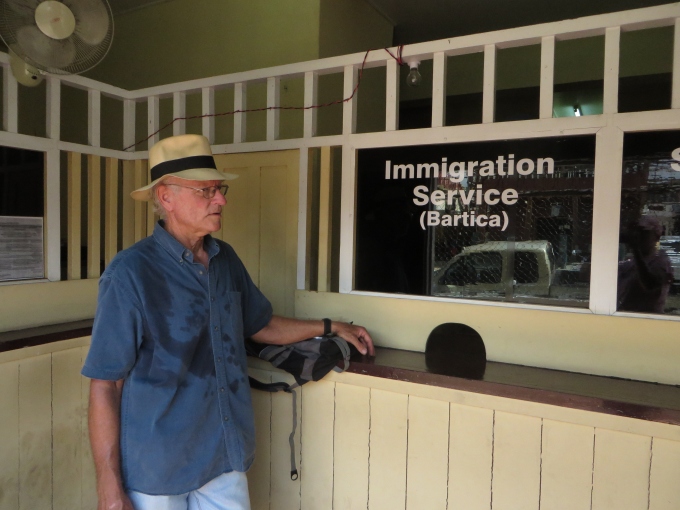Welcome to Bartica
/Bartica, (pronounced BAHR-ti-kah), a small port town of ~15,000+ people, is located on the Essequibo River, at the confluence of the Cuyuni and Marzaruni Rivers, about 50 miles upriver from the Atlantic. It's called the “Gateway to the Interior” as it's the key jumping off spot for freelance miners, known as pork knockers, that scour the alluvial fields of Guyana's interior for gold and diamonds. More about pork knockers later.

We arrived just before Noon, launched the dinghy, and after feeling comfortable with our anchorage and holding, headed into town to check-in. We dinghied up and down the wharf to determine a place to tie up. No place was immediately evident. At the fast ferry dock, we asked and were pointed upriver to a raft of boats tied aft and stern not far away.
We nudged our way between the nestled boats up to a ramshackle hut with a wooden loading ramp that was missing about every other plank. A young black fellow grabbed our painter as we gingerly climbed out of the dinghy and made our way up the steep, rickety ramp, over a cement embankment and onto land. He would tie up the boat and we'd pay him later. Good, since we didn't have any Guyanese currency yet. The narrow muddy trail along the shore led to an alley which finally dumped us out on the main street, First Avenue. We made a mental note for our return that the little alley was next to a Digicel Top-Up sign.
Our first stop was Immigration on First Avenue. It may be a small town, but it seemed everyone was out and about either walking or driving. We arrived just after lunchtime (Noon-1pm) at the Immigration office, but no one was around. We waited a half hour and finally checked in with the police next door. They promised to give the guy a call. He showed up about 10 minutes later, apologetic, and after completing our entry forms and showing him our paperwork, he stamped our passports and directed us to an ATM in order to be able to pay our Customs' fees
We found the Scotia Bank on Second Avenue without much trouble and withdrew G$30,000 from the 24/7 ATM . It's an affiliate bank of Bank of America … no withdrawal fees involved. (Hooray!) Seemed like a lot of money (~US$150) and it was dispensed in all crisp G$5,000 notes. There's always a sigh of relief when our ATM card works in a new country. We headed immediately to Customs back on First Avenue across from Immigration. The office was located down an alley with no signs, next to Church's Chicken and up a steep cement staircase. We completed more forms and paid our G$2,500 incoming fees. We were legal in Guyana. The whole process took about 90 minutes … most of it spent waiting.
It was mid-afternoon now, hot and steamy. David had read that Digicel offered prepaid data packages here in Guyana and throughout the Caribbean and they had an office in Bartica. We found it at the other end of First Avenue and waited our turn in line. No complaints … the shop was air-conditioned. After much discussion, it was determined that Digicel did not sell dongles/digital modems for the computer … at least not in Bartica. If we could get our iPad unlocked, they could sell us a SIM card and we could then buy a prepaid data package. Though this wouldn't be optimal for transferring blogs and pics, it was doable and better than nothing. We went in search of the “unlock” guy, but his “office” was closed on a Friday afternoon.
We decided to check out the Central Market, a couple supermarkets and generally get the lay of the land. The Central Market was pretty much done for the day...early morning is best, so we'd return another day. There were several small supermarkets with basic supplies. We noticed lots of American products … Bush's beans, Heinz ketchup, Kellogg's Frosted Flakes. Brazilian products were plentiful as well. The prices were horrendous, but considering where we were, probably reasonable just for the effort of getting the products here. Demerara sugar, produced locally, was a bargain, however, at G$240. Rice and beans seemed plentiful and were sold in quantities from huge 25kg (55#) sacks down to individually packaged small plastic bags.
Mike and Tessa's General Store on First Avenue has been around quite awhile. We poked our heads in … five cans of this and four cans of that on the shelves. They sold lots of bulk products like flour, rice and beans. They still weighed everything on an old-fashioned balance scale. Rubber boots hung from the ceiling and we imagined during the rainy season, they'd be in high demand.
There were bars and drinking establishments on every corner and several in between. We saw cases of the local Banks Beer being unloaded. Some men staggered along the streets and we figured they'd begun their drinking early.
The Morocco offered three beers for G$1000. Three beers for a thousand dollars … even for Guinness that seemed high until we did the math … ~US$1.50 each.
It was late afternoon when we tried to find our way back to the dinghy dock. It seems that our landmark, a Digicel Top-Up Sign, was one of many along First Avenue. We finally managed to find the right alley and retrace our steps to retrieve the dink. Heading over the cement embankment and down the steep, now slippery, every-other-plank-missing ramp was a bit awkward, but we managed. Our dinghy parking valet brought the dinghy back to the edge of the ramp. We paid our G$500 fee and nudged our way back out of the parking lot and back to Cups. Enough exploring for one day. Time for dinner, a cold beer and a movie. Tomorrow's another day and we're looking forward to it.



































